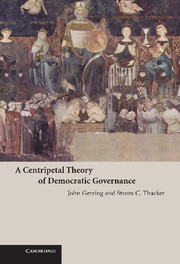Book contents
- Frontmatter
- Contents
- List of Figures
- List of Tables
- Acknowledgments
- A Centripetal Theory of Democratic Governance
- 1 Models of Governance
- PART ONE CAUSAL MECHANISMS
- PART TWO EMPIRICS
- PART THREE CONCLUSIONS
- Appendix A Defining Good Governance
- Appendix B Alternative Theories Revisited
- Sources
- Author Index
- Subject Index
1 - Models of Governance
Published online by Cambridge University Press: 06 July 2010
- Frontmatter
- Contents
- List of Figures
- List of Tables
- Acknowledgments
- A Centripetal Theory of Democratic Governance
- 1 Models of Governance
- PART ONE CAUSAL MECHANISMS
- PART TWO EMPIRICS
- PART THREE CONCLUSIONS
- Appendix A Defining Good Governance
- Appendix B Alternative Theories Revisited
- Sources
- Author Index
- Subject Index
Summary
Why are some countries better governed than others? This venerable question has innumerable possible answers. Variation in the quality of governance may be attributed to geography, economics, class and ethnic group dynamics, social capital, and political culture. It is also presumably affected by geopolitical factors, by political leadership, and by diverse historical legacies.
In this book we focus on the role of political institutions – that is, government – in providing good governance. Other factors (societal, cultural, geopolitical, or contingent) lie in the background. Within the realm of polities, we focus on democratic regimes. We understand a country to be democratic when multiparty competition is in place. (We are not interested, therefore, in the role of political institutions in maintaining or undermining democracy, a subject that has received a good deal of attention from scholars.)
Why are many democracies plagued by corruption and ineptitude, while others manage to implement policies effectively and efficiently? Why do some democracies suffer from inefficient markets and low levels of investment while others enjoy low transaction costs, high levels of capital investment, and strong economic growth? Why are rates of morbidity, mortality, illiteracy, and other aspects of human well-being depressingly high in some democracies and impressively low in others? More specifically, what effect do various political institutions have on the quality of governance in a democracy?
In this introductory chapter we lay out the currently dominant view on this subject, which we call decentralist, and set forth our own contrasting view, which we call centripetal.
- Type
- Chapter
- Information
- A Centripetal Theory of Democratic Governance , pp. 1 - 24Publisher: Cambridge University PressPrint publication year: 2008



